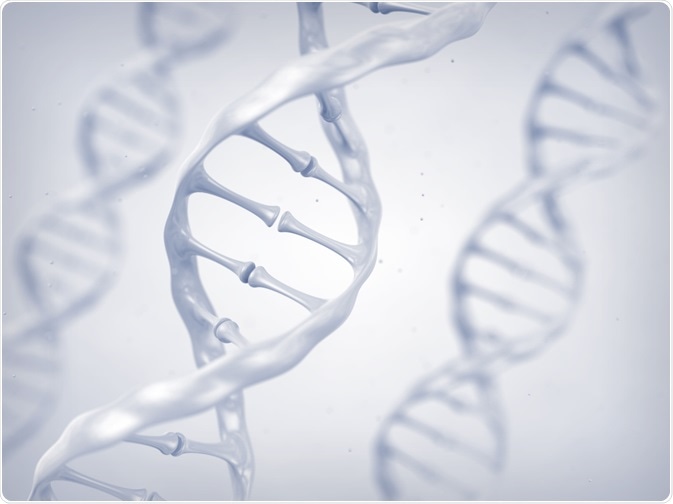What Shows the Phenotypes of Genetically Related Family Members.
The characteristics of an organism sally through complex interactions of its genetic make-upward and the effects of the surround. This article discusses this terminological distinction in genetics - that of the genotype, the heredity textile, or DNA, independent within genes and passed from one generation to the next, versus the phenotype, the physical and behavioral traits of an organism. The genotype-phenotype distinction is one of the virtually central concepts in biology and is crucially crucial to evolutionary theory.

Image credit: nobeastsofierce/Shuttershock.com
Here nosotros'll hash out how these terms were showtime introduced into biology, in the early part of the twentieth century, by the Danish botanist Wilhelm Johannsen (1857-1927). Since their first introduction, the meanings of genotype and phenotype have altered over time. Biologists have dismissed genetic reductionism, insisting no causal upshot between a unmarried gene and a phenotypic trait, for example. Although a unproblematic cause and effect human relationship may not exist, progress has been made in mapping genotypes to phenotypic characteristics.
Wilhelm Johannsen and the genotype conception of heredity
In 1911 Wilhelm Johannsen coined the terms genotype and phenotype when he proposed "The Genotype Conception of Heredity." The 2 categories class two fundamentally different levels of biological brainchild. The genotype refers to the genetic material passed between generations, and the phenotype is appreciable characteristics or traits of an organism.
While Johannsen produced novel and innovative inquiry in genetics and highlighted the need for accompanying new terminology, the American geneticist Alfred Henry Sturtevant (1891-1910) constructed a genetics map of the chromosome, having located specific genes of the fruit fly Drosophila.
Genotype versus Phenotype: A Primal Distinction
The combination of alleles possessed by an individual for a specific gene gives usa the genotype. The combination of alleles possessed by an private for a specific cistron gives us the genotype. For example, when because eye colour, if a person inherits a dominant brown allele (B) and a recessive bluish (b), they'll be genetically heterozygous for those characteristics. Equally one allele is dominant, the person will accept dark-brown eyes.
The phenotype, nevertheless, relates to the observable traits of an organism. Dissimilar the genotype, it is non inherited from its parents and is influenced by the genotype and several other factors:
- Environmental, east.g., nutrition, temperature, humidity, and stress
- Epigenetic factors
Once the stardom between these terms was established, enquiry has sought to sympathize the precise relationship betwixt the two. How do genotypes map onto phenotypes? Pursuing this line of inquiry has not been an easy task, oft linked to how their meanings have changed over fourth dimension.
Conceptual Confusion
Confusion concerning the concepts tin easily occur. Take the notion of 'phenotypic plasticity', a then-called rapid response adaptive mechanism that allows an organism to modify in response to environmental stimuli - to produce different phenotypes. Although this mechanism excludes the genome, changes in gene expression are a part of the procedure. Considering that some definitions of phenotypic plasticity refer to a genotype's environmental sensitivity, defining terminology clearly tin become difficult.
The use of genotype is confusing here - environmental sensitivity does not mean the genome itself responds directly to the environs. Rather phenotypic plasticity involves a change in the phenotype without a permanent genetic modify in the individual. Information technology is divers as the range of phenotypes that an organism can express as a function of its environment and is the resultant component of the GxE (genotype by environment) interaction.
No Straightforward Causal Connection
The is no clear causal connection between the genotype and the phenotype, and Genome-Wide Association Studies - an approach used in genetics research to see if any variant is associated with a trait - accept made this ever more apparent. Human genetic clan studies of unmarried nucleotide polymorphisms (SNPs) explain only a small-scale proportion of manifest phenotypic variation, and this may be due to:
- Rare SNP'southward
- Structural and epigenetic variants
- Synergistic genetic interactions
- Multiple alleles with additive effects
- Multiple alleles with additive effects
The accent placed on multiple genetic interactions with numerous environmental variables is problematic for assessing the genotype-phenotype relation.
Recently, researchers accept chosen for a return to emphasizing the genotype-phenotype human relationship as a connection between differences at two dissimilar biological levels, as originally argued by Johannsen. The differential view of this relationship will be a useful explanatory framework in the context of pleiotropy, epistasis, and environmental effects.
The Genotype-Phenotype Distinction in Medical Genetics
Agreement the connection between genotype and phenotype is essential for several research avenues, including medical approaches. Rapid genome-sequencing methods and whole-genome transcription profiling offering the prospect of predicting phenotype from a genotype.
DNA sequence changes have been linked to phenotypic differences at the individual and species level in eukaryotic organisms using these methods. In humans, the OMIM catalog (Online Mendelian Inheritance of Man) is a compilation of genetic determinants of affliction-related phenotypes.
References
- Dowell, R. (2010) Genotype to phenotype: a circuitous trouble. Scientific discipline. doi: https://doi.org/ten.1126/scientific discipline.1189015
- West-Eberhard, Grand. (2008) Phenotypic Plasticity. Encyclopaedia of Environmental. https://doi.org/ten.1016/B978-008045405-4.00837-5
- Orgogozo, V. et al. (2015) The differential view of genotype-phenotype relationships. Front Genet. doi: https://doi.org/x.3389/fgene.2015.00179
- Fox, R. et al. (2019) Across buying fourth dimension: the role of plasticity in phenotypic adaptation to rapid environmental alter. Phil. Trans. Roy. Soc. B. https://doi.org/x.1098/rstb.2018.0174
Further Reading
- All Genetics Content
- History of Genetics
- Genetics and Gene Expression
- Genetic Change
- Genetics Research and Technology
Source: https://www.news-medical.net/health/Genotype-Versus-Phenotype.aspx
0 Response to "What Shows the Phenotypes of Genetically Related Family Members."
Publicar un comentario